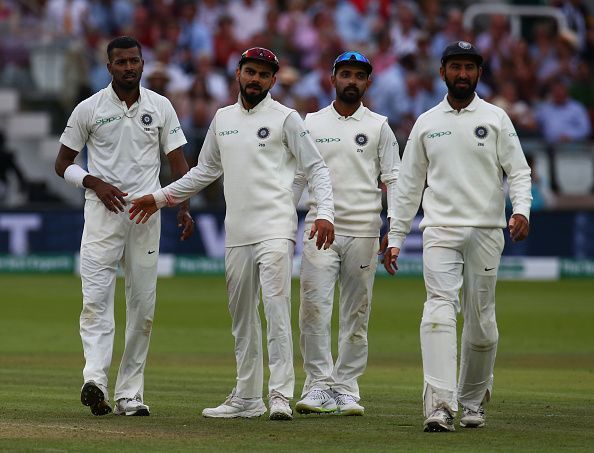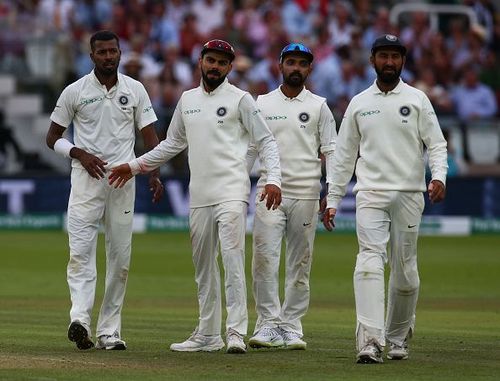
When will India learn from its overseas mistakes?

Every time the current Indian team sets its foot for an overseas tour, there is a sense of belief that Virat Kohli's men can go all the way. In fact, one aspect that has put our trust in the current side- a piece of the jigsaw that was missing from the earlier teams- is a potent fast bowling unit.
However, despite good performances from the bowling battery, it has been a similar old story for the Indian team. Generally, India's batting unit did well for the team without getting back the required support from the bowlers.
In fact, it has been a completely different story on the last two tours. India's bowlers were able to take all the twenty wickets in the last seven matches (excluding the second Test match at Lord's). However, the shortage of good scores by the Indian batsmen on the board has let the team sink like Titanic.
So, where does the problem lies?
One of the major reasons that have acted as a big iceberg in this story - is the preparation.
India played only one warm-up match before the first Test at Edgbaston, Birmingham which could have gone either way. Just one warm-up match isn't enough. Oh, in fact, they did better than the South African tour where they played nought.
Again, poor scheduling by the Board of Control for Cricket in India, Virat Kohli?
No, the Indian skipper was happier this time around. He said that the limited-overs series will help his team in getting acclimatized to the conditions. Kohli had said the following before jetting off to England.
“But yes, the conditions are going to be different, we will have to respect that. By the time the Tests come, we’ll be so comfortable that we won’t even feel like we’ll be playing an away series.
“So, once you spend time there, you get comfortable and that’s the biggest factor. If you are at ease mentally, it will show in your performances.”
However, the Indian skipper must have understood that there is a day and night difference between white and red ball format. You can get accustomed to the conditions but the longest format brings out the biggest challenges in the game.
Being patient, waiting for the loose deliveries, fighting it out in the middle in arduous conditions, leaving the balls especially in the initial stages of the innings, knowing where off stumps is, giving respect to a good spell, judging the length of the ball, the pace of the track, the bounce in the pitch, playing the ball late, no jagging at the balls are the pillars on which a good Test batsman builds his fort. A brick of this, not put in the right place can lead to destruction. And it takes only one ball to do the irreparable damage.
However, such attributes of the game have been missing from the arsenal of Indian batsmen in the first two Tests. In fact, it is not that Indian batsmen are flat track bullies. They had proven their mettle in the third Test match against South Africa at Johannesburg, where they fought like brave soldiers.
Even the Indian team intensity in the warm-up game was poor. Yes, you are not expected to put your 100% in a practice match. But the Virat Kohli's men just wanted to get it done with the warm-up match as a mere formality.
Meanwhile, Virat Kohli has been the lone warrior and he was able to demonstrate all these qualities with great control at Edgbaston, albeit after getting two lives.
Kohli was India's helmsman in the first Test who had stood out in the thundering situations. Like a good captain of the ship, Kohli was just one step away from single-handedly guiding his team to the shore. However, he could not cross the last strong wave the England bowler's, especially Ben Stokes threw at him and the team.
Meanwhile, India's batting woes have been perennial in the last two years. Virat Kohli has done the bulk of the scoring with him scoring 526 runs whereas the rest of the top five batsmen have scored 505 runs (in the last five Test matches, three in South Africa, two in England). Kohli has averaged 52.60 while none of the specialist batters has an average of more than 20. Thus, the numbers tell us why India has been a one-man army
Interestingly on the other hand, if we rewind the pages of history, the Indian teams who have savoured success in England have played more warm-up matches.
In 1971, Ajit Wadekar, who breathed his last yesterday, led India to a 1-0 series win in England for the first time. The secret of the win - eight warm-up matches before the first Test match at Lord's on July 22.
In 1986, Kapil Dev led India to a 2-0 series win in England. Again the secret of that win - six warm-up matches before the first Test match, again at Lord's on June 5.
In 2007, Rahul Dravid led India to a 1-0 triumph in England. The secret of that series win - yes you guessed it right, two warm-up matches before the first Test at Lord's, one more tour match before the third Test at Oval.
Thus, there is a simple pattern. If you want to be successful in England conditions, you need to prepare well. In fact, it doesn't mean only practice matches will help, County stints also play a huge role as many players have reaped fruits.
Meanwhile, Indian batting has fallen like a house of cards and England has made full use of the home conditions. The overcast conditions have helped James Anderson and Co. in blowing away the Indian batsmen with the wind.
Consequently, the players need to play more red ball form, the BCCI will need to cut out on the limited overs schedule. Subsequently, there would be a cut down in revenue. So, the Indian board needs to make a decision for the good of Indian cricket. Furthermore, the workload of the players needs to be managed better.
There is nothing in cricket that BCCI cannot do. It is high time for the Indian board to invest in the purest form of the game. Otherwise, all we will receive out of foreign tours will be- disappointment.